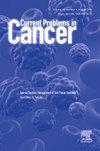基于临床患者和肿瘤特征的乳腺癌新辅助治疗结果预测:一项横断面研究
IF 2.3
4区 医学
Q3 ONCOLOGY
引用次数: 0
摘要
乳腺癌是女性人口中最常见的恶性疾病,也是发达国家最常见的疾病之一。许多可能影响这种复杂疾病的发展和结果的因素已经被研究。本研究的目的是分析影响新辅助治疗结果的因素,并基于这些因素建立结果预测模型。材料与方法收集2018 - 2022年在本临床中心接受乳腺癌新辅助治疗的所有患者的数据。统计分析包括识别与RCB指数值显著相关的患者和肿瘤特征,使用Spearman相关系数、Mann-Whitney u检验、单向方差分析和Kruskal-Wallis检验。选择有意义的特征并用于基于随机森林算法的机器学习模型的训练。结果患者的特征、年龄、BMI和既往恶性疾病史与RCB指数有显著相关性。肿瘤的显著特征包括病灶、核分级、免疫表型、雌激素受体、孕激素受体和HER-2阳性、Ki-67值以及有无淋巴血管浸润。基于这些特征,建立了预测模型,预测精度为80%,ROC-AUC值为0.83。结论发现的显著特征与已发表的文献基本一致。虽然我们的预测模型产生了有希望的结果,但其训练受到患者数量和数据可用性的限制。进一步的研究和建立更准确的预测模型可能有助于进一步个性化和改进乳腺癌新辅助治疗。本文章由计算机程序翻译,如有差异,请以英文原文为准。
Breast cancer neoadjuvant therapy outcome prediction based on clinical patient and tumor features: A cross-sectional study
Introduction
Breast cancer is the most common malignant disease in the female population and one of the most common diseases in developed countries. Many factors which may impact the development and outcome of this complex disease have been investigated. The aim of this study was to analyze factors that affect neoadjuvant therapy outcomes and create an outcome prediction model based on these factors.
Materials and methods
Patient data was collected from all patients who underwent breast cancer neoadjuvant therapy at our clinical center from 2018 to 2022. Statistical analysis entailed the identification of patient and tumor features that are significantly associated with RCB index values, using Spearman’s correlation coefficient, the Mann-Whitney U-test, and the one-way ANOVA and Kruskal-Wallis test. Significant features were selected and used for the training of a machine-learning model based on the random forest algorithm.
Results
Regarding patient features, age, BMI, and previous history of malignant disease were found significantly associated with the RCB index. Significant tumor features included focality, nuclear grade, immunophenotype, positivity for estrogen receptors, progesterone receptors and HER-2, Ki-67 value, and presence of lymphovascular invasion. Based on these features, a predictive model was created with an accuracy of 80 % and ROC-AUC value of 0.83.
Conclusion
The discovered significant features are mostly in line with the published literature. While our predictive model yielded promising results, its training was limited by the number of patients and availability of data. Further research and the creation of more accurate predictive models might facilitate further personalization and improvement of breast cancer neoadjuvant treatment.
求助全文
通过发布文献求助,成功后即可免费获取论文全文。
去求助
来源期刊

Current Problems in Cancer
医学-肿瘤学
CiteScore
5.10
自引率
0.00%
发文量
71
审稿时长
15 days
期刊介绍:
Current Problems in Cancer seeks to promote and disseminate innovative, transformative, and impactful data on patient-oriented cancer research and clinical care. Specifically, the journal''s scope is focused on reporting the results of well-designed cancer studies that influence/alter practice or identify new directions in clinical cancer research. These studies can include novel therapeutic approaches, new strategies for early diagnosis, cancer clinical trials, and supportive care, among others. Papers that focus solely on laboratory-based or basic science research are discouraged. The journal''s format also allows, on occasion, for a multi-faceted overview of a single topic via a curated selection of review articles, while also offering articles that present dynamic material that influences the oncology field.
 求助内容:
求助内容: 应助结果提醒方式:
应助结果提醒方式:


